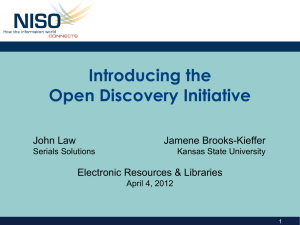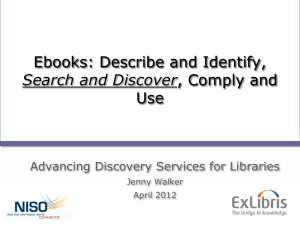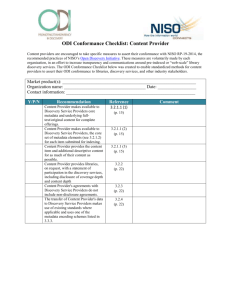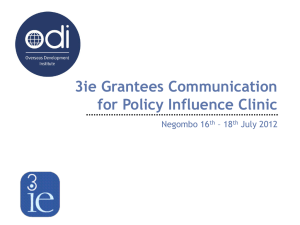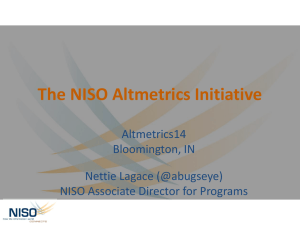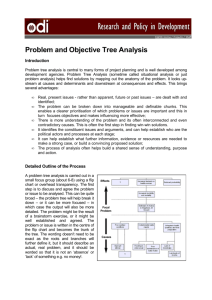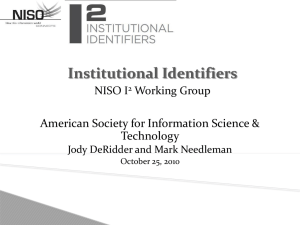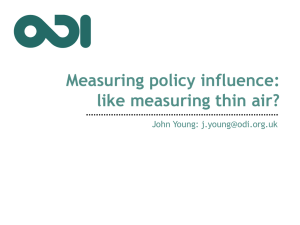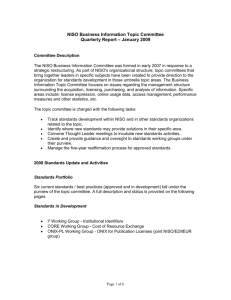The Future of Library Resource Discovery
advertisement
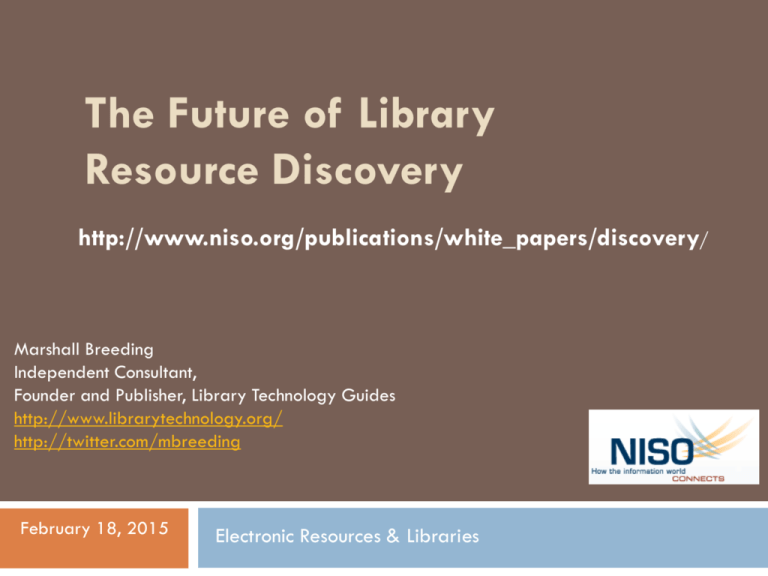
The Future of Library Resource Discovery http://www.niso.org/publications/white_papers/discovery/ Marshall Breeding Independent Consultant, Founder and Publisher, Library Technology Guides http://www.librarytechnology.org/ http://twitter.com/mbreeding February 18, 2015 Electronic Resources & Libraries Description In 2014, NISO commissioned a trends and strategy white paper, "The Future of Library Resource Discovery." The paper, covering an area of significant interest for libraries, provides an overview of the current research discovery environment and investigates technologies and practices which may present growth opportunities to support and improve user experience. Update on the NISO Open Discovery Initiative Balance of Constituents 4 Libraries Marshall Breeding, Vanderbilt University Jamene Brooks-Kieffer, Kansas State University Laura Morse, Harvard University Ken Varnum, University of Michigan Sara Brownmiller, University of Oregon Lucy Harrison, College Center for Library Automation (D2D liaison/observer) Michele Newberry Publishers Lettie Conrad, SAGE Publications Roger Schonfeld, ITHAKA/JSTOR/Portico Jeff Lang, Thomson Reuters Linda Beebe, American Psychological Assoc Aaron Wood, Alexander Street Press Service Providers Jenny Walker, Ex Libris Group John Law, Serials Solutions Michael Gorrell, EBSCO Information Services David Lindahl, University of Rochester (XC) Jeff Penka, OCLC (D2D liaison/observer) ODI deliverables 5 Standard vocabulary NISO Recommended Practice: Data format & transfer Communicating content rights Levels of indexing, content availability Linking to content Usage statistics Evaluate compliance Inform and Promote Adoption ODI Timeline 6 Milestone Target Date Appointment of working group Dec 2011 Approval of charge and initial work plan Mar 2012 Completion of information gathering Jan 2013 Completion of initial draft Jun 2013 Completion of final draft Sep 2013 Public Review Period commences Sep 2013 NISO Publishes Recommended Practice June 2014 Status ODI Recommended Practices NISO RP-19-2014 http://www.niso.org/workrooms/odi/ http://www.niso.org/workrooms/odi/publications/rp/rp-19-2014 Metadata elements for content providers to contribute to discovery service providers Content providers disclose extent to which they participate with each discovery service Discovery Service providers disclose what content is represented in index Discovery services disclose any bias in search results or relevancy relative to business relationships Discovery services provide use statistics ODI Standing Committee Fulfilling recommendation of the ODI that NISO charge an ongoing committee to promote ODI best practices and related issues. Discussions may include but are not limited to: brainstorming on ways to publicize and educate the community on ODI answering any support questions checking on status of vendor support liaising with other standards efforts as applicable determining when is an appropriate time to consider updating ODI ODI Standing Committee Roster Laura Morse – Harvard University Lettie Conrad – SAGE Aaron Wood – Ingram Content Elise Sassone – Springer Jason Price – SCELC Jill O’Neill – NFAIS Julie Zhu – IEEE Marshall Breeding – Independent Consultant John McCullough – OCLC Michael McFarland – Credo Rachel Kessler – Ex Libris Scott Bernier – EBSCO Steven Guttman – ProQuest Ken Varnum – University of Michigan Library NISO Discovery White Paper Commissioned by NISO Discovery to Delivery Topic Committee First Draft Nov 2014 Revised draft submitted in Feb 2015 with expected publication Feb 20, 2015 NISO Discovery Paper Outline General Background Integration between Discovery Services and Management Systems Linked Data Gap Analysis Opportunities for Future Enhancements in discovery Discovery Beyond Library-provided Interfaces Open Discovery Initiative: recommendations for Phase II Longer term prospects General Background Discovery interfaces Index-based discovery services Non-library discovery Public library discovery products Comprehensive library portals Bento Box Discovery Model Aggregated Content packages ILS Data VuFind / Blacklight Search Results Web Site Content Digital Collections Institutional Repositories Consolidated Index Search: Open Access E-Journals Pre-built harvesting and indexing Web-scale Index-based Discovery ILS Data Digital Collections Search: Usagegenerated Data Customer Profile Consolidated Index Search Results Web Site Content Institutional Repositories Aggregated Content packages … Open Access E-Journals Reference Sources Pre-built harvesting and indexing State of Discovery indexes Very strong coverage of primary publishers of scholarly materials Especially Weaker coverage of scholarly content in other international regions Asian English and other Western Languages languages, Arabic, etc. Mixed coverage of A&I resources Mixed converge of non-textual resources Comprehensive Library Portal Public Interfaces: Presentation Layer Integrated Library System Library Web site Subject Guides Article, Databases, E-Book collections Discovery Service Installations Product 2007 2008 2009 2010 2011 2012 2013 2014 Installed EBSCO EDS 1774 2634 8246 Primo 12 37 53 506 111 101 98 88 1528 AquaBrowser 55 339 64 69 74 58 81 6 89 Encore 72 72 109 56 72 BiblioCommons Summon Enterprise 50 16 36 346 41 ~200 164 214 158 238 195 697 75 100 102 123 150 538 18 74 95 404 Infor Iguana Axiell Arena 61 57 33 35 Multi-Role Stakeholders Content provider / Discovery Service EBSCO Information Service ProQuest Resource Management / Discovery Provider OCLC Ex Libris Possibilities for Open Access discovery index Open source tools exist for discovery Interfaces: VuFind Blacklight No open access discovery indexes High threshold of expense and difficulty to build index Platform costs Software development Publisher relations Billions of content items to index and maintain Current model requires massive resources Threshold of resources required currently too high for open access central discovery index Assessment might change if options narrowed Opportunities to lower barriers to entry? More open model more likely to come through linked data discovery model Interoperability of Discovery Services and Management Platforms Discovery and Management solutions offered as matched sets Independent Discovery and Management Ex Libris: Primo / Alma ProQuest: Summon / Intota OCLC: WorldCat Discovery Service / WorldShare Platform Kuali OLE: no discovery component EBSCO Discovery Service: Works with any Resource management system Both product categories depend on an ecosystem of interrelated knowledge bases API’s exposed to mix and match, but are efficiencies and synergies are lost? Recommendation to explore expectation regarding interoperability between these two product categories Linked Data Major trend toward information systems based on linked data Many projects now based on linked data Area of peak interest for Library of Congress, OCLC, etc BIBFRAME Potential to transform how libraries approach discovery Likely interim hybrid models: central indexes + Linked Data Current opportunities in making library content more discoverable Linked data Not yet a fully operational method for libraryoriented content Increasing representation of bibliographic resources BIBFRAME stands to make great impact Universe of scholarly resources not well represented Will current expectations for content providers to make metadata or full text available for discovery expand to exposure as open linked data? Hybrid models Can index-based search tools be improved through Linked Data Browse to related resources Add additional hierarchies of structure to search results Gap Analysis Many resources still not addressed in central indexes Especially A&I products Better coverage of open access materials Better support for internationalization and multilingual search and retrieval Improved capabilities for precise search, known items, browsing Improved and more transparent relevancy rankings Non-textual content and retrieval mechanisms Better integration with learning management systems Opportunities for Future Enhancements in discovery Improved delivery of APIs More coherent ecosystem of APIs among discovery services and with resource management systems Social features and scholarly collaboration Address research data Special Collections and archival materials: hierarchical discovery and browsing Expanded Analytics and Altmetrics Discovery Beyond Library-provided Interfaces Reality that most discovery happens external to library Improve discoverability of library resources Locally: through incorporation of SEO and semantic encoding Especially Globally: schema.org OCLC, Google Scholar and other services Discovery beyond Library Interfaces Improved performance of library content through Google Scholar Same expectations for transparency? Better exposure of library-oriented content Schema.org Better exposure of scholarly resources Open or other microdata formats access & Proprietary Embedded tools in other campus interfaces Schema.org encoding <div itemscope="itemscope" itemtype="http://schema.org/Article"> <h2> <span itemprop="headline"> Library Technology Forecast for 2015 and Beyond </span> </h2> </div> <!-- End microdata itemscope div --> Sample Resource page Interpreted by Google Rich Snippets http://www.google.com/webmasters/tools/richsnippets Interpreted by Google Rich Snippets Interpreted by Google Rich Snippets Open Discovery Initiative: recommendations for Phase II Address A&I concerns to improve participation Data exchange mechanisms: metadata + content Lower threshold of participation Interoperability with resource management systems Participation of A&I in Discovery Libraries expect participation A&I providers have concerns: Fear that inclusion in discovery will devalue A&I subscriptions If content not positioned well, libraries may not see evidence of value and drop subscriptions How is the brand of A&I presented to users when accessed through discovery interface Statistical validation of contributions of A&I to resource selection in discovery services A&I Content in Discovery Services What is the place for A&I services in the discovery ecosystem Are there technology solutions capable of substituting for A&I content? Specialized and scoped search methodologies Clustering, term extraction, etc.? Specialized vocabulary and other metadata make positive contributions to the discovery process Researchers value A&I tools Potential Opportunities for NISO Convene a second phase of the Open Discovery Initiative Launch research project on open linked data in scholarly publishing sector to facilitate new models of discovery and access Expand scope of Altmetrics group to address their integration in discovery service ecosystem Possible new workgroup to explore recommended practices for improving discoverability of resources via open linked data, schema.org, and other mechanisms. Longer term prospects Opportunities for discovery directly tied to realities in scholarly publishing Dominance of proprietary publishing requires index-based discovery Future to open access and exposure as open linked data will enable additional models of discovery Questions and discussion
